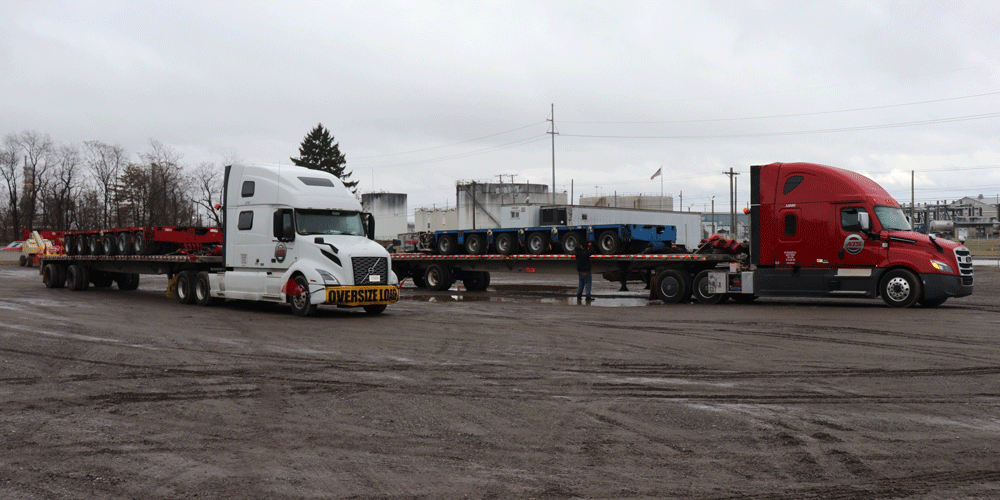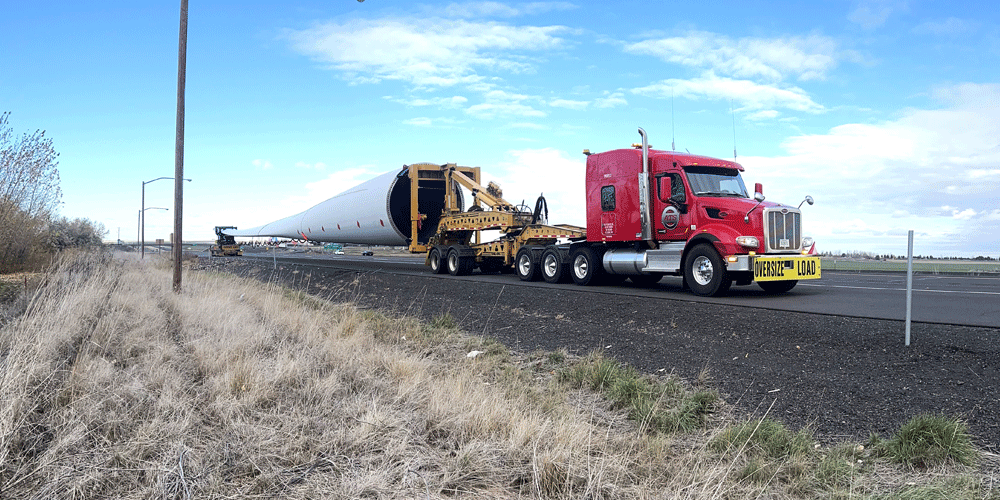Lars has been in the trucking industry his whole working life. He started working in the shop when he was just 16 years old. Lars spent about 10 years in operations before moving to driver recruiting. He spent five years in recruiting before joining the ATS team as the vice president of driver recruiting. He currently serves as the vice president of van operations. No day is ever the same in the trucking industry and Lars enjoys the challenge that presents.
Hello, Q2!
Does anyone else find that 2024 is moving really fast? Three months of the year: Gone in the blink of an eye.
As we dive into Q2, we embrace spring, the start of baseball season, the Masters Golf Tournament, and Coachella. Okay, maybe not the last one, but it is happening in April.
Spring is a season of transition, where we see snow melting, construction projects starting up, road crews starting to work on the highways again, and produce season ramping up.
This season of transition doesn't go unnoticed in the transportation world. If you don’t account for these changes, you do yourself harm. Instead, you should plan accordingly so you can sail through Q2 and into Q3 with success in your pocket.
In the following article, we’ll touch on the following:
- Q1 recap
- Q2 freight rates
- Q2 freight availability
- Tips for success in Q2
In this article, you’ll get a good look at what you can expect for the next three months in the trucking world. This will give you the information you need to make informed decisions about your trucking business or career.
What Happened in the Trucking Industry in Q1?
Wondering what happened in Q1? The answer is a whole lot of nothing. Q1 is notoriously slow in the trucking industry and 2024 Q1 was no different. For the most part, rates continued to fall and drivers continued to struggle through it.
We saw an inkling that contract and spot rates would start to change, with an imbalance in spot rates. As contract rates continue to fall, companies may start switching to spot market freight. It looks like we could be moving in the right direction, or at least seeing some relief in sight, but there’s no telling how true that is just yet.
We saw a dip in volume in early March, which may have been due to some weather delays in February.
A lot of publicly traded companies reported a less-than-stellar Q4 and predicted the same for Q1. We exited the first quarter as we entered it. Volume is improving but pricing isn’t great. We’ve been ping-ponging along the bottom for a long time now but we still aren’t there yet.
Most notably in Q1, on March 26, the Dali, a 984-foot cargo ship flown under the Singapore flag, hit a support pillar of the Francis Scott Key Bridge in Baltimore, Maryland, sending the bridge into the Patapsco River. The devastation to the victims, their families, and the people of Baltimore is paramount.
The shipping community also took a hit. As the ninth-largest port in the nation for overall volume and one of the largest in the nation for automobile imports and exports, the Port of Baltimore and its function are crucial to a large supply chain.
While we have experienced supply chain disruptions before (notably, the Red Sea and Panama Canal disruptions throughout 2023), it’s still important to note that some things will have to change.
The Fort McHenry marine channel needs to be cleared before vessels can navigate it again. That means no freight is coming in or out. The port is closed indefinitely at the time of this writing, but the hope is that at least partial service will be possible at the end of April.
If you’re a driver who frequents the Port of Baltimore for freight, you’ll have to find a different port to do business in. If you frequent Baltimore, you may encounter traffic delays and lengthy reroutes. We’ve already noticed significant transit time increases in the area.
The Federal Motor Carrier Safety Administration (FMCSA) issued a waiver for commodities rerouted from the port. If you’re hauling in this area, check out the new FMCSA waiver here.
Freight Rates in Q2
Experts predict that 2024 could turn out to be more of a normal year for the freight industry. May looks like it could be when the market picks up, leading the way for a better Q2 than the one we saw in 2023.
Rates for those hauling produce will increase as the demand for delivering fresh products across the country increases. A long West Coast rainy season will contribute to a short burst in increased reefer rates.
Freight Availability in Q2
Rates are notoriously tough in Q1 as a lot of the country is blanketed in snow and ice. Q2 makes way for spring seasonality that can boost freight availability.
Produce season will ramp up in mid-Q2, which will increase the demand for reefers. Harvest in the southern states — think juicy peaches, strawberries, and more — will start to surge as we navigate into Apri and May. This will continue through the summer months.
Outbound port freight on the West Coast starts to pick up after April, too.
Frost Laws should start to subside at the start of Q2 as snow makes way for rain and flowers, so you’ll no longer have to worry about which roads you can and cannot drive on based on winter road conditions. This will make routing easier for you.
Flatbed hauling becomes a lot easier because of this. Industries like agriculture and housing starts will pick up, so open-deck freight will need to move again. Housing starts are up about five percent over last year at this time and peaking specifically in the Midwest and Southeast. Projects will also probably pick up again, so count on seeing more multi-truckload projects.
On the van side, home and gardening supplies pick up — same with summer clothing — as everyone starts to prep their gardens and get ready for summer.
On a driver capacity side, we haven’t seen any major trucking companies leave the industry like we’d anticipated. Instead, we’re starting to see drivers leave the industry entirely. Some are going back to jobs they previously held and some are finding jobs in the manufacturing, construction, and trade fields.
As a truck driver, you have to be away from home a lot. To do that, drivers want to be paid a premium. If that premium starts to tighten — which has been the case for the last several years — they start to leave the industry. This can open up capacity a bit for you in the coming months.
Tips for Successfully Hauling Freight in Q2
Keep Doing More of the Same
To navigate Q2, you’ll want to do more of what you’ve been doing the last few months. If you want to turn the biggest profit, you’ll have to spend more time out on the road and less time at home. When you do go home, be strategic about it and make sure you have money saved up to cover your expenses — like your truck payment and insurance.
Even as rates improve — and we hope they do in the next six months — it’s a good idea to continue this practice. Save as much money as you’re able and make smart decisions about the freight you haul. Keep working hard to capitalize on the market. The worst thing you could do right now is to work less and spend all your money.
These tips will help you navigate the freight recession.
Switch Trailers
To capitalize on the freight boom, you may consider switching to reefer trailers. Fresh produce will keep you moving.
Watch Your Idle Time
When it warms up, the temptation to idle your truck excessively rises. Don’t spend all your money on the cost of fuel to idle.
Traditionally, spring and summer months come with an increase in fuel prices. More people will be traveling for family road trips and vacations, so demand increases.
Now is the time to be smart about fueling.
Don’t Lose Track of Safety
With more people traveling on the roads during the summer and road construction taking over the roads, it can be easy to get frustrated and forget safe driving behaviors.
Don’t lose your usual heightened sense of awareness and safety. Follow road construction signs and give yourself extra space.
Prepare for Blitz Week
DOT Blitz Week is on May 14 - 16 this year. The focus is on tractor protection systems and alcohol and controlled substance possession. You’re also subject to having your entire tractor and trailer inspected along with your driver credentials.
Prepare by reviewing your tractor protection systems, including the tractor protection valve, trailer supply valve, and anti-bleed back valve to make sure they’re in proper working order.
Avoid any violations by getting your truck in the shop for any lingering repairs that may be caught during an inspection.

Make the Most of the Busy Season Ahead
Heading into Q2 of 2024, it's a crucial time to get ready for a season full of changes. Spring is here, which means there's going to be a lot more work available, especially with construction projects kicking off and the demand for fresh produce going up. Being prepared for these changes is key to having a successful few months.
The beginning of the year was pretty slow for the trucking industry. Rates were down and you probably felt the pinch. But looking ahead to Q2, things seem a bit brighter, especially for those hauling fresh produce.
Adjust to the season's needs as much as you can. Manage expenses carefully by saving money where possible and be smart about fuel use, especially since fuel prices tend to go up during the warmer months. Safety should be your other big focus.
Q2 of 2024 looks promising for truck drivers who are prepared to adapt to the season's demands. By focusing on opportunities like the increase in produce shipments, being wise about expenses, and maintaining a strong commitment to safety, you can navigate through the challenges and make the most of the busy season ahead.
Check out these tips to be a top earner!


